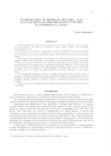Introduction of Tropical Legumes and Development of Legume-Based Pastures in Subtropical Japan
Tropical agriculture research series : proceedings of a symposium on tropical agriculture researches
| ISSN | 03889386 |
|---|---|
| 書誌レコードID(総合目録DB) | AA00870529 |

本文フルテキスト
tars18-_173-185.pdf2.03 MB
In the assessment of the economic and ecological environment of subtropical Japan emphasis has been placed on the need for introducing tropical pasture legumes and developing legume-based pastures.
Differences in plant responses to temperature, soil pH, and drought stress among introduced legume species and cultivars have indicated that sub-tropical Japan can be divided into several zones, according to the climatic and edaphic ranges within which different species may become adapted.
Yield potential and feeding value assessment in the field under representative climatic and edaphic conditions has shown that in the southern part of sub-tropical Japan Macroptilium atropurpureum, Centrosema pubescens and Stylosanthes guianensis have a potential in the hilly areas and Leucaena leucocephala and M. atropurpureum could be adapted to the lowland areas with moderately acid to alkaline soils, while in the northern part Lotononis bainesii, Desmodium uncinatum and M. atropurpureum could be adapted to the hilly areas and D. intorlum, D.uncinatum, Neonotonia wightii, M. atropurpureum and Trifolium semipilosum to the lowland areas.
For developing management practices of legume-based pastures under special ranges of ecological conditions in sub-tropical Japan, the following aspects were considered: time and methods of sowing; defoliation treatments; fertilization of acid and alkaline soils; selection of companion grasses; utilization of effective strains of Rhizobium; and forage conservation methods.
Finally, an outline of the genotypes which should be introduced preferentially into each zone is presented.
Differences in plant responses to temperature, soil pH, and drought stress among introduced legume species and cultivars have indicated that sub-tropical Japan can be divided into several zones, according to the climatic and edaphic ranges within which different species may become adapted.
Yield potential and feeding value assessment in the field under representative climatic and edaphic conditions has shown that in the southern part of sub-tropical Japan Macroptilium atropurpureum, Centrosema pubescens and Stylosanthes guianensis have a potential in the hilly areas and Leucaena leucocephala and M. atropurpureum could be adapted to the lowland areas with moderately acid to alkaline soils, while in the northern part Lotononis bainesii, Desmodium uncinatum and M. atropurpureum could be adapted to the hilly areas and D. intorlum, D.uncinatum, Neonotonia wightii, M. atropurpureum and Trifolium semipilosum to the lowland areas.
For developing management practices of legume-based pastures under special ranges of ecological conditions in sub-tropical Japan, the following aspects were considered: time and methods of sowing; defoliation treatments; fertilization of acid and alkaline soils; selection of companion grasses; utilization of effective strains of Rhizobium; and forage conservation methods.
Finally, an outline of the genotypes which should be introduced preferentially into each zone is presented.
| 刊行年月日 | |
|---|---|
| 作成者 | Yukio Kitamura |
| 公開者 | Japan International Research Center for Agricultural Sciences |
| 巻 | 18 |
| 開始ページ | 173 |
| 終了ページ | 185 |
| 言語 | eng |
